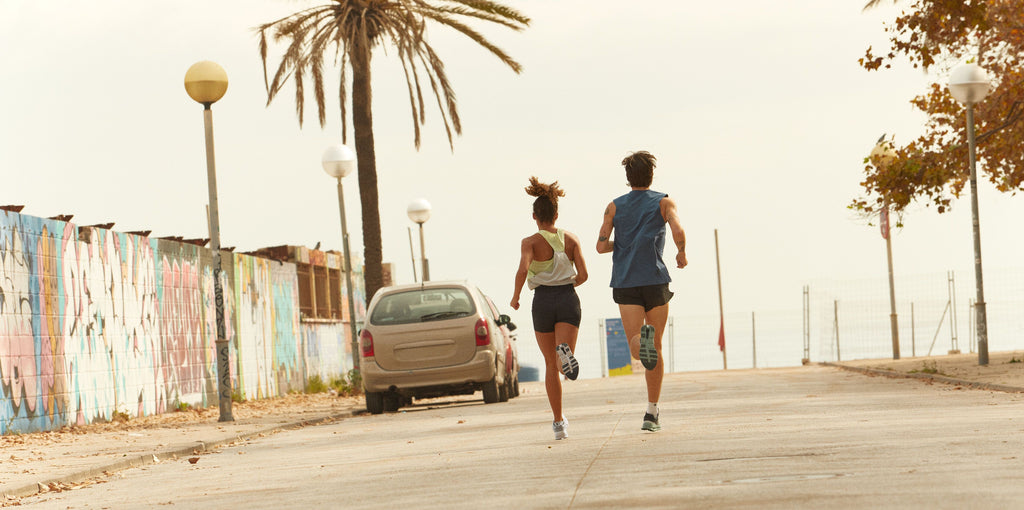When should you buy new running shoes for your event?
Why you shouldn't do a race in brand new running shoes.
Yes, there is a “break-in” period for running shoes, but exactly how long does it take to break in new shoes and why shouldn’t you run a race in brand new shoes?
Stick around and we’ll answer all your “new shoe” related questions here!
When should I buy new running shoes in general?
A lot of factors determine when you will need new running shoes. Everything including your training volume, the environment you are running in, your weight, foot strike/biomechanics, and the type of shoes you prefer all determine when they will need to be replaced.
Logically speaking, thinly stacked shoes and/or shoes with less rubber on the outsole will “expire” faster. If you mostly run on uneven surfaces or in trails, your shoes will also tend to take more of a beating.
If you don’t track the mileage on each pair of your training shoes, paying attention to these key indicators can help determine when to replace your shoes:
- Your body or feet are unusually sore or you start getting blisters
- The treads are worn down, there are holes in the bottom, or you’ve had them for more than 6 months
- If you reach 500-800km on one pair
- Or whichever of the above comes soonest
Here’s how to extend the life of your running shoes.
When to buy new running shoes before a race?
While new shoes nowadays only take about 10 miles to break in, you’ll want to buy new running shoes around three weeks before your race.
This way, you have a chance to do quite a few short runs and one moderate to long run in them. And if the pair you receive happens to be a lemon, you have more than enough time to return them.
There are also a few key questions to consider when buying new shoes before a race, like:
How long is your race?
For shorter races, you’ll be far less likely to injure yourself in new shoes than if you were running say a half or full marathon.
The training for these types of races usually includes a taper period of about two weeks, so it will make sense to get new shoes just before the beginning of your taper period.
Are you planning on racing in carbon shoes or “regular” running shoes?
Due to the nature of the carbon fiber construction of plated running shoes, these runners tend to “expire” a lot faster than your everyday trainers. They are also more rigid by nature because they are designed to propel you forward when running at high speeds, however, this also means that the carbon fiber breaks down more quickly. You’ll get maybe 200 miles out of these shoes, so run a few shorter tempos in them to get used to how they feel, and then have at it!
Are you buying a brand/model of shoe you have used before?
If you’ve been training in a particular model, even a certain version of a model, they will take less time to break in. It is not advisable to try something completely new right before a big race like a marathon, so if your preferred model isn’t available, at least stick with the same brand you’ve been using.
Here’s how to tell when you need new running shoes.
WHY you should buy new shoes (and break them in) before a race.
If you’ve been training properly for your big event like a half or full marathon, you’ll have logged hundreds of KMs in the process. The fact of the matter being, a single pair of shoes should not be used for an entire training cycle AND the goal race.
You can extend the life of a single pair of shoes by rotating them with other pairs, but if that’s not in the budget, making sure you get a new pair 2-3 weeks before your race is a good commitment to start with.

What could happen if you run a race in brand new shoes?
Even if you’re buying the exact same pair and version of shoe that you’ve been training in for four months, you should not go from the store directly to your race. Your body still does need time to adjust to a new shoe, especially when you’ll be running much faster for farther than your usual training runs.
If you run a hard race in brand new shoes be prepared to experience form-related injuries, the worst blisters of your life, a possible DNF if your shoes are uncomfortable, stress fractures, and other horror stories.
Choosing the best running shoe for your upcoming race or workout.
Are you wondering what a running shoe rotation is or need some extra guidance on picking out a winner? Look no further.
If you’re still not sure when to buy your shoes or how to tell whether the fit is right for you, visit your friendly neighbourhood running store for some expert advice. Plus, shopping locally positively impacts your surrounding community.




